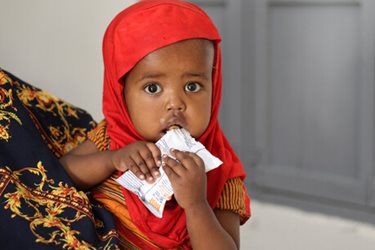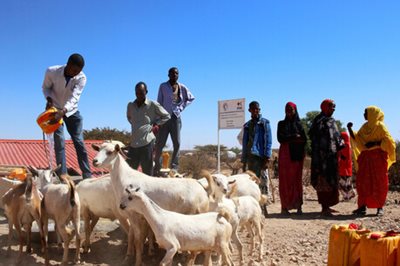Across the Horn of Africa, severe ongoing drought is reshaping the lives of millions as the lack of water destroys livelihoods, causes mass migration, and is the reason for increasing malnutrition.
“Before I came to this village I was a pastoralist,” said Rama Ali Warsame, from her makeshift shelter on the edge of Hilgo. Her family, like many, moved in search of water.
“The drought has killed our livestock …. there is no pasture and people are in a critical situation.”
She had a herd of more than 70 goats, now she only has a handful.
Wherever the Somali Red Crescent Society (SRCS) works, they hear this story as five failed rainy seasons over the past two-and-a-half years has destroyed people’s ability to grow food and killed off their goats, sheep, camels, and cattle. This means families have lost their income.
Basra Ahmed Cabdale would grow tomatoes and onions, which her family would eat with sorghum and maize. They would also have milk and meat from their animals.
“Our biggest worry is the loss of our animals and the lack of food,” she said. “We hope we get enough rainfall to grow crops and feed our livestock.”
Getting water now is difficult.
“It takes two hours [to walk to the water point] and we have to form a long queue to get it,” Basra said.
With her animals dying and needing to sell surviving animals to buy food and other basic needs, Basra is unable to protect her livelihood in the future.
She brought her two children Muhiyadin Abdikadir, 1, and Nimco Adbikadir Hassan, 3, to be screened for malnutrition at the SRCS supported clinic near Borama. Her daughter Nimco was found to be moderately malnourished, so Basra received food supplements like porridge and the high-calorie Plumpy'Nut.
 She isn’t alone. More and more children are not able to get adequate nutrition. Mothers talk of only having enough to cook rice, once per day, and sometimes children don’t eat at all.
She isn’t alone. More and more children are not able to get adequate nutrition. Mothers talk of only having enough to cook rice, once per day, and sometimes children don’t eat at all.There are three criteria involved in measuring famine. An area needs to have 20 per cent of households facing an extreme lack of food and 30 per cent of children suffering from acute malnutrition. Acute malnourishment can lead to children not surviving, or even if they do survive, their growth and development is permanently impacted. The third part of the criteria is two adults or four children in 10,000 are each day dying of starvation.
To put this in context – if we were talking about a famine happening in a city with the population of Ottawa it would mean 62 children under 14 years old dying per day, Vancouver 148 children, in Toronto it would be 153 children dying per day. From a lack of food.
The situation isn’t a famine yet, but it is a humanitarian crisis, which is made worse by climate change and conflict.
The key to supporting families is a combination of emergency response and long-term resilience building and planning for the future.
The SRCS with support from Red Cross, Red Crescent partners, including Canadian Red Cross with thanks to funds from the Government of Canada and donors are doing exactly that; ensuring money is getting into the hands of families and working with communities to lessen the impacts of climate change.
 Emergency cash transfers through mobile money, means people, like Koos Ahmed Mahmoud, are able to buy food for their children and feed for their animals. This allows her to hang on to her livelihood, easing recovery when the rain finally starts again.
Emergency cash transfers through mobile money, means people, like Koos Ahmed Mahmoud, are able to buy food for their children and feed for their animals. This allows her to hang on to her livelihood, easing recovery when the rain finally starts again.“This support has changed us. Before there weren’t any ways to get things that we need,” she said. “I covered the needs of my children with food and other things including water, rice, sugar, milk, pasta, and vegetables.”
By working with communities to get roofs on community water points, called berkeds, SRCS supports climate change resilience.
“Our biggest worry is in the community is water,” community member Khadra Abdi Suldan, said. “The biggest challenge in the future is water.”
Traditional berkeds were open to allow filling by rain and access for animals. The rehabilitated berkeds have roofs that prevent evaporation, and systems to gather the rainwater when it does rain. In the meantime, the community brings in water by truck, an investment that is now safe because of the roof.
“We are thanking SRCS, because they have rehabilitated and covered the berked,” she said.

